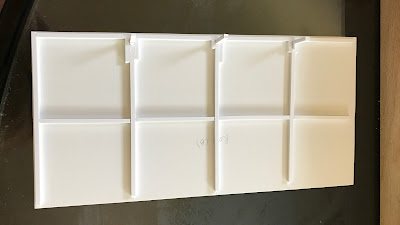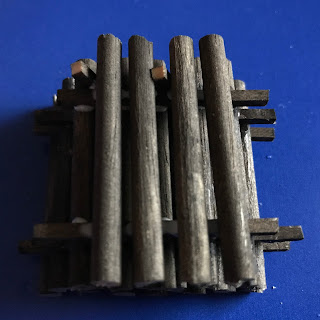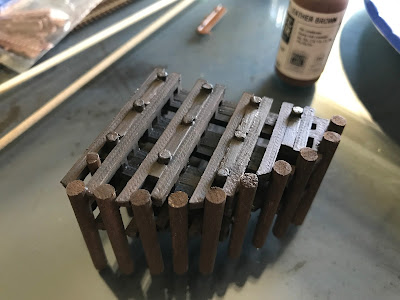Had some time over the weekend to continue working on the American Can Company.
Picked yet another arrangement of walls, fabricated floors and the roof for the South end, and started painting the wall sections for the North end:
August 21, 2017
August 16, 2017
American Can Company
With work stress reaching new local maximums, it was time to switch gears back to the shelf layout. One of the big industries for the layout is the American Can Company, which featured a large operation on Illinois Street. Here's a picture from the SF Public Library:
The building literally looks like it came out of the Walther's catalog, so after a trip to the "personal hobby shop," I dug out some older kits— and by older, I mean at least two 20+ year old kits still in boxes.
I spent some time mulling over options and decided that combining the "Brach's Candy Factory" along with the newer "American Hardware Supply" would do the trick.
After some a bunch of cutting splicing, resorting to Sharpie markers for the mullions, and swearing, I ended up with this:
July 30, 2017
The Other Pier End
With the "insane" pier end complete, I shifted gears over to the "other" end pilings. Here are a few cropped images from the drone video that I used as a starting point:
Rather than messing with plastic, I decided to build this entire assembly using wood dowels, scale lumber, and my new best friend Formula 560 Canopy glue:
When I got to the third layer, I realized I needed to add the diagonal braces from the prototype. I makes some adjustments and re-glue some of the pilings while everything is still workable:
Thankfully, I realized the error in my ways before the glue completely dried—only a single piling should be between the diagonal bracing. The next phase was to wrap the main assembly with the smaller pilings. I trimmed the bracing with flush cutters, added several beads of glue, and then wrapped my small pilings around the entire assembly:
I didn't like how the bracing wasn't evident,so I added an additional layer of scale lumber to bring the details closer to the top. Now to let the entire thing dry tonight:
July 28, 2017
Shelf Layout Progress
In this week's work session, my friend and I got a chance to get the two boxes built-up. Most of the time was spent setting up the drill press to be able to correctly install the alignment pins.
Test fitting the 2x2 endplates; the holes and pins worked:
Added two holes for wiring, a third hole a 5/6" bolt, and finally a set of holes to allow for the modules to be cleanly separated:
Dry fitting and gluing the plywood tops in place:
Waiting for the glue to dry before the next session:
Test fitting the 2x2 endplates; the holes and pins worked:
Added two holes for wiring, a third hole a 5/6" bolt, and finally a set of holes to allow for the modules to be cleanly separated:
Dry fitting and gluing the plywood tops in place:
Waiting for the glue to dry before the next session:
July 26, 2017
Portable Switching Layout
Started construction of the benchwork for Illinois Street shelf layout. Cut two 12" x 36" long plywood tabletops as a start:
Adding 1x2 and 2x2 hardwood framing below the layout to provide some strength and make room for the low profile switch machines and other electronics. Side rails are fine without additional woodwork— will eventually trim plywood flush, as it was a tiny bit longer than 36":
Cutting the oak cross braces to length:
Dry fitting the side rails and end/cross bracing:
Adding 1x2 and 2x2 hardwood framing below the layout to provide some strength and make room for the low profile switch machines and other electronics. Side rails are fine without additional woodwork— will eventually trim plywood flush, as it was a tiny bit longer than 36":
Cutting the oak cross braces to length:
Dry fitting the side rails and end/cross bracing:
July 23, 2017
Patience is a Virtue
Spent another insanely hot day working on the pier end. After the initial coat of paint was dry, I finally had a chance to add on the real wooden parts to the structure. Formula 560 Canopy Glue turned out to be my weapon of choice, as it will adhere wood to plastic, dries fast, and dries clear.
For some context, here's the assembly placed adjacent to the under construction ferry slip:
Once the large pilings were in, I shifted attention to wrapping the structure with the smaller pilings. Several attempts were needed to wrap a painted plastic structure around the hulk to attach the outer pilings. After lots of trial and error, including some ill advised attempts to use CA adhesive, I got things to work. It turns out PRE-bending the plastic worked much better than attempting to bend while gluing.
While the NASCAR Brickyard 400 race playing in the background, I methodically attached the outer piers one or two at a time.
Around the time the race ended (it went to overtime) I was finished with this daunting task:
For some context, here's the assembly placed adjacent to the under construction ferry slip:
Detailing and Paint
After assembling the prints together, I decided to go ahead and add the additional timers, along with some Tichy nut/bolt/washer castings. I am looking to add interest to the most exposed side of the print, and draw attention away from any printing artifacts.
After the primer dried overnight, I added some additional layers of Vallejo acrylic paint. Some full strength German Camo Black Brown, and some washes of Leather Brown. I'm debating about whether to add any additional lighter washes, as every time I add a lighter shade, the printing artifacts appear to be enhanced. As I'm modeling the pier much earlier than any of my reference photos, I also need to restrain myself from over-distressing the structure.
The next step was to apply a "base" primer coat to the entire assembly. I stole a trick from my military modeling friends and instead of using a gray primer, I sprayed the whole thing with Games Workshop Chaos Black primer. The idea here is to get my "shadows" for free.
After the primer dried overnight, I added some additional layers of Vallejo acrylic paint. Some full strength German Camo Black Brown, and some washes of Leather Brown. I'm debating about whether to add any additional lighter washes, as every time I add a lighter shade, the printing artifacts appear to be enhanced. As I'm modeling the pier much earlier than any of my reference photos, I also need to restrain myself from over-distressing the structure.
July 21, 2017
July 20, 2017
Now with more layers
Pier prints look good, added some "pilings" and now I need to do more adjusting before glue and paint.
Subscribe to:
Comments (Atom)


















































